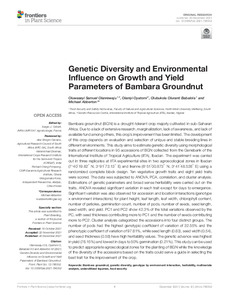| dc.contributor.author | Olanrewaju, O.S. |
| dc.contributor.author | Oyatomi, O. |
| dc.contributor.author | Babalola, O.O. |
| dc.contributor.author | Abberton, M. |
| dc.date.accessioned | 2022-03-07T12:51:40Z |
| dc.date.available | 2022-03-07T12:51:40Z |
| dc.date.issued | 2021-12-20 |
| dc.identifier.citation | Olanrewaju, O.S., Oyatomi, O., Babalola, O.O. & Abberton, M. (2021). Genetic diversity and environmental influence on growth and yield parameters of Bambara groundnut. Frontiers in Plant Science, 12:796352, 1-15. |
| dc.identifier.issn | 1664-462X |
| dc.identifier.uri | https://hdl.handle.net/20.500.12478/7380 |
| dc.description.abstract | Bambara groundnut (BGN) is a drought-tolerant crop majorly cultivated in sub-Saharan Africa. Due to a lack of extensive research, marginalization, lack of awareness, and lack of available fund among others, this crop’s improvement has been limited. The development of this crop depends on evaluation and selection of unique and stable breeding lines in different environments. This study aims to estimate genetic diversity using morphological traits at different locations in 95 accessions of BGN collected from the Genebank of the International Institute of Tropical Agriculture (IITA), Ibadan. The experiment was carried out in three replicates at IITA experimental sites in two agroecological zones in Ibadan (7◦40′ 19.62′′ N, 3◦91′ 73.13′′ E) and Ikenne (6◦51′ 00.873′′ N, 3◦41′ 48.528′′ E) using a randomized complete block design. Ten vegetative growth traits and eight yield traits were scored. The data was subjected to ANOVA, PCA, correlation, and cluster analysis. Estimations of genetic parameters and broad sense heritability were carried out on the traits. ANOVA revealed significant variation in each trait except for days to emergence. Significant variation was also observed for accession and location interactions (genotype x environment interactions) for plant height, leaf length, leaf width, chlorophyll content, number of petioles, germination count, number of pods, number of seeds, seed length, seed width, and yield. PC1 and PC2 show 42.3% of the total variations observed by the PC, with seed thickness contributing more to PC1 and the number of seeds contributing more to PC2. Cluster analysis categorized the accessions into four distinct groups. The number of pods had the highest genotypic coefficient of variation of 32.55% and the phenotypic coefficient of variation of 97.61%, while seed length (0.63), seed width (0.54), and seed thickness (0.58) have high heritability values. The genetic advance was highest in yield (76.15%) and lowest in days to 50% germination (0.21%). This study can be used to predict appropriate agroecological zones for the planting of BGN while the knowledge of the diversity of the accessions based on the traits could serve a guide in selecting the best trait for the improvement of the crop. |
| dc.description.sponsorship | Global Crop Diversity Trust |
| dc.description.sponsorship | CGIAR |
| dc.format.extent | 1-15 |
| dc.language.iso | en |
| dc.subject | Food Security |
| dc.subject | Legumes |
| dc.subject | Genotype Environment Interaction |
| dc.subject | Genetic Diversity |
| dc.subject | Bambara Groundnut |
| dc.title | Genetic diversity and environmental influence on growth and yield parameters of Bambara groundnut |
| dc.type | Journal Article |
| cg.contributor.crp | Genebanks |
| cg.contributor.affiliation | North-West University |
| cg.contributor.affiliation | International Institute of Tropical Agriculture |
| cg.coverage.region | Africa |
| cg.coverage.region | West Africa |
| cg.coverage.country | Nigeria |
| cg.coverage.hub | Headquarters and Western Africa Hub |
| cg.researchtheme | Biotech and Plant Breeding |
| cg.identifier.bibtexciteid | OLANREWAJU:2021a |
| cg.isijournal | ISI Journal |
| cg.authorship.types | CGIAR and developing country institute |
| cg.iitasubject | Food Security |
| cg.iitasubject | Genetic Improvement |
| cg.iitasubject | Grain Legumes |
| cg.iitasubject | Plant Breeding |
| cg.journal | Frontiers in Plant Science |
| cg.notes | Open Access Journal; Published online: 20 Dec 2021 |
| cg.accessibilitystatus | Open Access |
| cg.reviewstatus | Peer Review |
| cg.usagerightslicense | Creative Commons Attribution 4.0 (CC BY 0.0) |
| cg.targetaudience | Scientists |
| cg.identifier.doi | https://doi.org/10.3389/fpls.2021.796352 |
| cg.iitaauthor.identifier | Michael Abberton: 0000-0003-2555-9591 |
| cg.futureupdate.required | No |
| cg.identifier.issue | 796352 |
| cg.identifier.volume | 12 |

